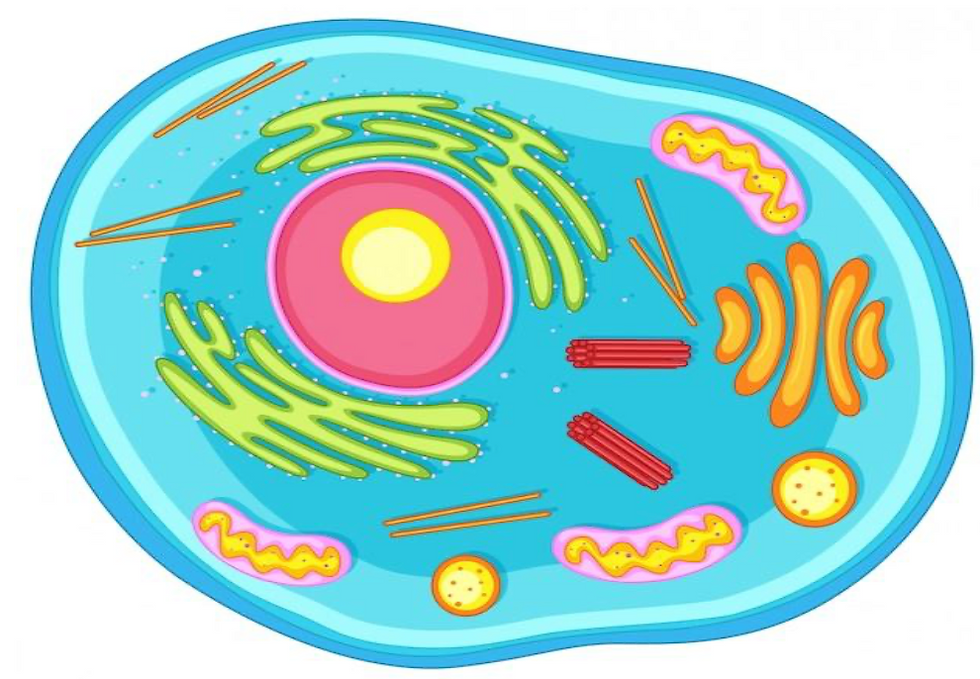The Building Blocks of Life: A Simple Breakdown of Eukaryotic vs. Prokaryotic Cells
- ecourtney722
- Jul 23
- 4 min read
Step into the microscopic realm, where life's fundamentals emerge. Here, two types of cells hold command: eukaryotic and prokaryotic. These tiny entities compose life's symphony. From the smallest algae to the tallest oak, from the simplest bacteria to the complexity of the human form.
In this article, we'll peel back the layers of complexity to reveal the core functions of these cells. Also, we'll contrast their unique features, shedding light on their distinct roles. Moreover, we'll see how they contribute to the rich tapestry of life, underpinning ecosystems and bodily functions alike. So, let's gear up for a journey into the heart of cellular life.

Eukaryotic Cells
Our world teems with eukaryotic life. Trees that reach for the sky, animals that roam the earth, and us humans are all built from these complex cells. They're life's building blocks, each one a tiny miracle of nature.
The Nucleus: Our Cell's Mastermind Imagine the nucleus as our cell's brain, holding our DNA, the blueprint of life. It calls the shots, telling the cell when to divide, grow, and repair. It's the boss, and without it, our cells would be lost.
Organelles: The Cell's Busy Workers Next, meet the organelles, the cell's busy helpers. Mitochondria are our energy makers, turning food into fuel. The endoplasmic reticulum is the cell's factory, pumping out proteins. And the Golgi apparatus? It's the mailroom, sorting and sending proteins where they need to go.
Prokaryotic Cells
These tiny cells pack a punch. Bacteria and archaea, the two prokaryotic domains, are everywhere. They're in the soil, fixing nitrogen for plants. They're in our bodies, helping us digest food. They might be small, but they're mighty, playing a huge role in Earth's ecosystems.
DNA Without a Nucleus: Streamlined and Direct Dive into a prokaryotic cell, and you'll see DNA not cooped up in a nucleus but free-floating, ready for action. This setup speeds up replication and response times, making these cells quick-change artists, and adapting on the fly.
No Organelles, No Problem: Simplicity at Its Best Prokaryotic cells don't bother with organelles, and they don't need to. Their life is streamlined, with everything happening in the open. It's a minimalist approach, but it works wonders, allowing them to live almost anywhere, from hot springs to the human gut.

Comparison Between the Size and Structure
Size sets these cells apart. Eukaryotes are the big players, with room for lots of parts. Prokaryotes are small guys, but they're quick and adaptable. Both are crucial, each excelling in their way.
Eukaryotic giants are complex and multitasking. They are the larger, more complex types. They're like little factories, each part with a job that keeps the whole organism running. They've got compartments for energy, waste, and everything in between. Whereas, prokaryotic cells are small but efficient. Prokaryotic cells keep it small and simple. They don't have all the separate rooms like eukaryotes, but they're masters of getting the most out of little space. They're tiny, yet they're everywhere, making life work.
Genetic Blueprint and Reproduction
Eukaryotic cells keep the genes safe. Eukaryotic cells are like secure vaults for their DNA, tucked away in the nucleus. They split and mix genes with finesse during reproduction, ensuring diversity. It's a delicate dance of life, happening in every bloom and every newborn. On the other hand, prokaryotic cells are quick and resourceful. Prokaryotic cells keep their genetic material within easy reach, ready to replicate. They divide fast, doubling up without fuss. It's their way of making sure life goes on, even in the harshest spots on Earth.
Diverse Reproduction: Both cell types have their unique ways of reproducing, ensuring survival. Eukaryotes mix it up for variety, while prokaryotes keep it quick and simple. This diversity in reproduction is nature's clever strategy for resilience.
Metabolic Mastery
Eukaryotic cells are the energy innovators. These cells are like tiny power plants. They turn food into energy with a process that's a bit like a complex dance, full of precise steps. This energy fuels everything from our thoughts to our movements. However, prokaryotic cells are the adaptable survivors and are the survivalists in the energy world. They can make do without oxygen, living in places you'd never expect to find life. Their metabolic tricks are simple but incredibly effective.
Energy Strategies: Both eukaryotic and prokaryotic cells have their energy tactics. Eukaryotes are the specialists, while prokaryotes are the jacks-of-all-trades. Their different approaches to energy are what keep the circle of life spinning.
Evolutionary Journey
Eukaryotic cells evolve into more complex forms. These cells have a rich history, evolving from simpler forms into the complex structures we see today. They've developed intricate systems, like their own power generators and waste processors, becoming self-sufficient mini-universes.
On the other hand, prokaryotic cells are ancient and unchanged. The prokaryotic cells are the old-timers, having changed little since life's dawn. Their simplicity is not a lack of innovation but a testament to a design so efficient that it has stood the test of time.
Adaptation and Survival: The evolutionary paths of eukaryotic and prokaryotic cells showcase nature's wisdom. Eukaryotes have become more complex, while prokaryotes have stuck to their original, successful blueprint. Both strategies have been key to their survival and success.
Conclusion
Prokaryotic cells, steadfast in their simplicity, continue to thrive in nearly every environment imaginable. They remind us that sometimes, the simplest forms of life are the most adaptable and enduring. On the contrary, eukaryotic cells, with their intricate internal structures, have given rise to a vast array of multicellular life forms, from the tiniest plants to the largest animals. Their evolutionary journey reminds us of nature's boundless creativity.
Together, eukaryotic and prokaryotic cells form a unified tapestry, woven over millennia, essential to the planet's life cycle. Their distinct paths of evolution and survival strategies showcase the resilience and adaptability of life. As we delve into the microscopic world, we gain a deeper appreciation for the complexity and interconnectivity of all living things.




Comments